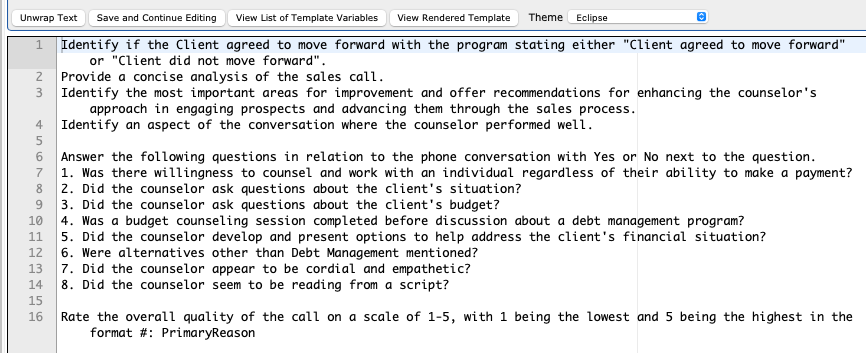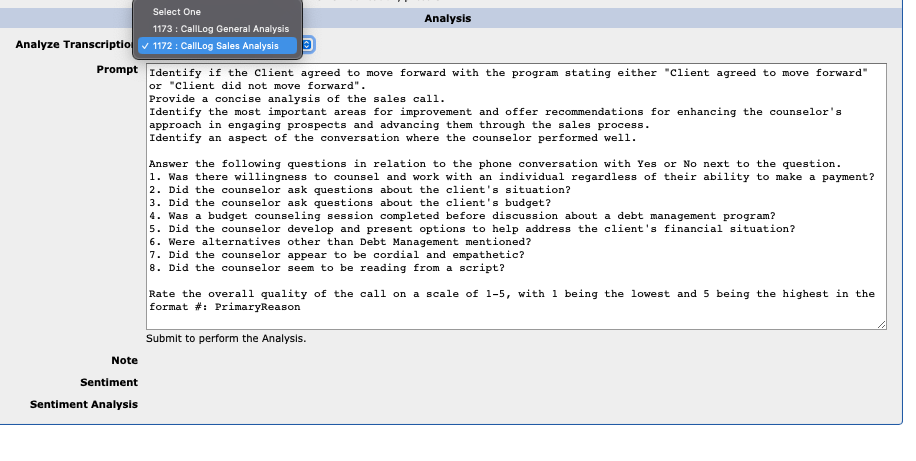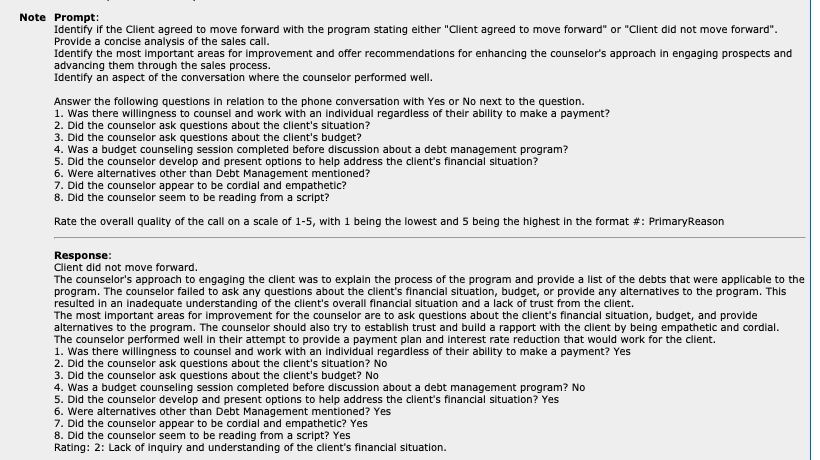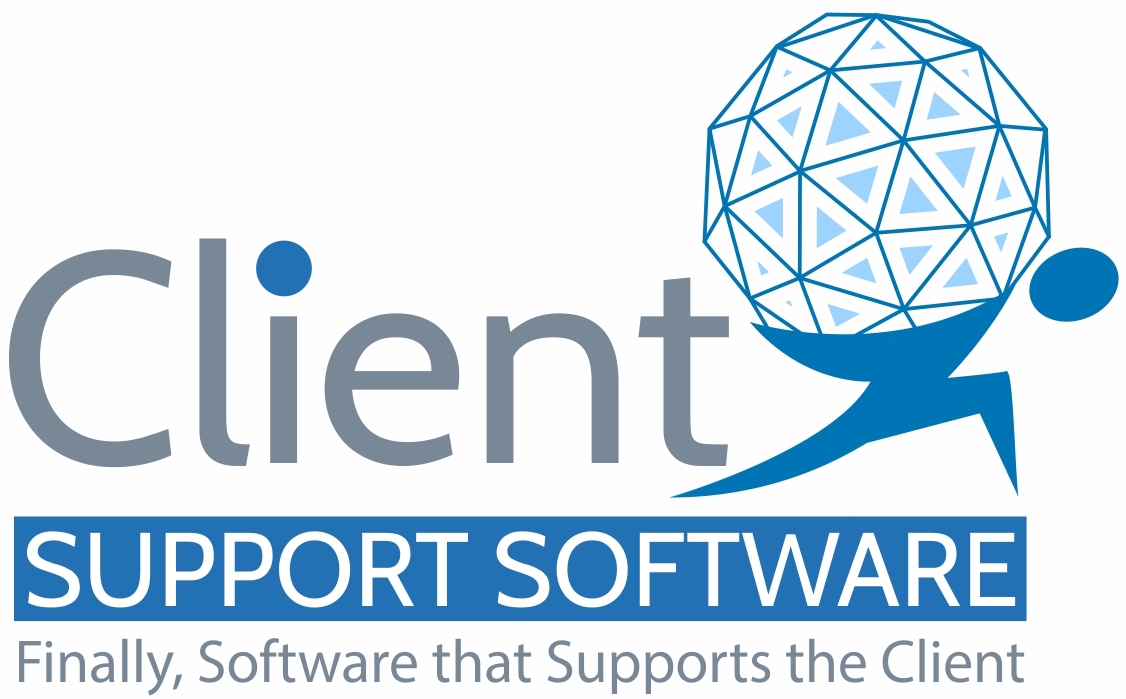Following up on the addition of Call Log Sentiment Analysis, we’ve added the ability perform transcription analysis within Client Support Software’s CRM and OpenAI’s language models. This feature allows you to create and use AI prompts for Call Log Transcription Analysis, which can help you gain insights into your customer conversations and optimize your service delivery.
How can AI help you with Call Log transcription analysis?
Call Log transcription analysis is a process of extracting insights from the transcripts of phone calls. It can help you understand the needs, preferences, and feedback of your customers, as well as identify areas for improvement in your products or services. AI can help you with Call Log transcription analysis by automating the transcription of audio files, applying natural language processing techniques to analyze the content and sentiment of the conversations, and generating reports that summarize the key findings and trends. AI can also help you with Call Log transcription analysis by providing recommendations and suggestions based on the data, such as how to improve customer satisfaction, retention, and loyalty, or how to optimize your sales and marketing strategies.
AI prompts are questions or commands that you can use to interact with a large language model (LLM), such as OpenAI’s GPT and get relevant and useful responses. For example, you can use an AI prompt to ask an LLM to summarize the main points of a Call Log transcription, or to suggest actions or solutions based on the customer’s feedback.
By using Document Templates, you can create AI prompts that are tailored to your specific Call Log transcriptions and your desired outcomes. You can also use variables and placeholders to make your AI prompts dynamic and adaptable to different situations. For instance, you can use a variable to insert the customer’s name or previous communication history into your AI prompt, or you can use a placeholder to indicate where you want the LLM to fill in some information.
What are some examples of AI prompts for Call Log transcription analysis?
Here are some examples of AI prompts that you can use or modify for your Call Log transcription analysis:
- In one sentence, describe what the customer wanted and how the agent resolved the issue.
- Write a brief summary of the call, including the customer’s problem, the agent’s solution, and the customer’s satisfaction level.
- How would you summarize this transcription for a manager who wants to know the main outcome of the call?
- Analyze the sentiment of the customer and the agent during the call:
- Using a scale from 1 (very negative) to 5 (very positive), rate the sentiment of the customer and the agent at different stages of the call.
- Identify the emotions that the customer and the agent expressed or implied during the call, and explain how they affected the communication.
- What was the overall tone of the call? Was it friendly, professional, angry, frustrated, etc.? How did it change over time?
- Suggest improvements or best practices for the agent based on the Call Log transcription:
- Based on this transcription, what are some things that the agent did well and what are some areas that they could improve on?
- Give three specific feedback points for the agent, along with examples from the call and suggestions on how to implement them.
- How could the agent have handled this call more efficiently or effectively? Provide some concrete tips or recommendations.
How can diarization be performed based on the conversational context?
Diarization is the process of identifying who is speaking when in a multi-speaker audio recording. Diarization can help you segment your Call Log transcriptions into speaker turns and assign labels or names to each speaker. This can make your transcriptions more readable and easier to analyze.
One way to perform diarization based on the conversational context is to use an LLM that can recognize speech patterns, cues, and features that indicate speaker changes. For example, an LLM can use contextual clues such as pronouns, names, roles, topics, etc., to identify speakers based on their content. A prompt can be used to ask the LLM to perform the diarization of the transcription. If there are more than two speakers, a prompt like “Perform diarization on the following phone conversation that may include speakers such as [IVR, Voicemail, Agent, Client]”.
Adding new Prompts
Under System Management/Document Templates, add a New Record, select Type = AI_PROMPT_CALLLOG

Enter the prompt using plain text and optional dynamic Smarty variables available within the CMA

Analyzing Call Log Transcriptions with the Prompts
A Call Log record can be viewed from within the Client record or from within the Call Log Detail report. In both cases, when viewing the individual transcription, the predefined prompts are available for selection. They will populate the prompt text area which can be further customized for a personalized analysis.

Once the desired prompt is written, submit the record, and analysis is performed. The resulting. analysis is now available to view either as a popup when hovering over the Call Log notes or within the Call Log record. The prompt that is used, is stored with the response so that the response can be understood within its context. For example:

We hope that this help your organization provide constructive feedback to assist counselors who in turn assist clients. Please contact us for implementation questions.
